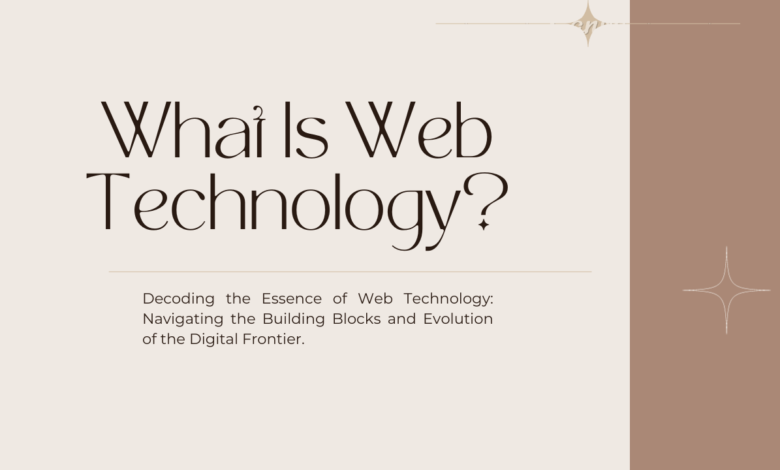What Is Web Technology?
Decoding the Essence of Web Technology: Navigating the Building Blocks and Evolution of the Digital Frontier.

What Is Web Technology?
Web technology refers to the tools, protocols, and software that enable the World Wide Web, facilitating communication and interaction between users and online resources.
Introduction
In the fast-paced digital age, where the internet plays an integral role in our daily lives, the term “web technology” has become increasingly prominent. But what exactly is web technology, and how does it shape the online world we navigate every day? This article aims to provide a comprehensive overview of web technology, exploring its definition, components, and the pivotal role it plays in powering the World Wide Web.
Defining Web Technology
Web technology encompasses the tools, techniques, protocols, and software that form the foundation of the World Wide Web. It is a broad term that encompasses everything from basic website development to complex, interactive web applications. At its core, web technology enables the communication and interaction between users and information resources over the internet.
Key Components of Web Technology
- Web Browsers: Web browsers serve as the gateway for users to access information on the internet. Popular browsers such as Google Chrome, Mozilla Firefox, and Safari interpret and display web content, allowing users to navigate websites seamlessly.
- HTML (Hypertext Markup Language): HTML is the fundamental building block of web pages. It provides the structure and layout for content on the internet, using tags to define elements such as headings, paragraphs, images, and links.
- CSS (Cascading Style Sheets): CSS complements HTML by controlling the presentation and layout of web pages. It allows developers to define styles, such as colors, fonts, and spacing, ensuring a consistent and visually appealing user experience.
- JavaScript: JavaScript is a dynamic scripting language that adds interactivity to web pages. It enables the creation of responsive and interactive features, such as sliders, forms, and real-time updates, contributing to a more engaging user experience.
- Web Servers: Web servers are software applications that store, process, and deliver web content to users. They respond to user requests, retrieve the necessary data from databases or files, and send the information to the user’s browser for display.
- Databases: Databases store and manage the vast amounts of data that power dynamic websites and applications. They allow for efficient retrieval and storage of information, supporting functionalities like user authentication, content management, and e-commerce transactions.
- Web Development Frameworks: Frameworks, such as React, Angular, and Vue.js, provide developers with pre-built components and structures to streamline the web development process. They facilitate the creation of scalable and maintainable web applications.
- Web Protocols: Protocols like HTTP (Hypertext Transfer Protocol) and HTTPS (HTTP Secure) govern the communication between web browsers and servers. They define how data is transmitted, ensuring secure and efficient data exchange.
Also Check
The Evolution of Web Technology
Web technology has evolved significantly since the early days of static HTML pages. The advent of Web 2.0 introduced dynamic, user-generated content, social media platforms, and collaborative online experiences. Today, with the rise of Web 3.0, we see the integration of technologies like artificial intelligence, blockchain, and the Internet of Things (IoT) into the web landscape, paving the way for more personalized and decentralized digital experiences.
Conclusion
Web technology is the backbone of the internet, shaping the way we access, interact with, and contribute to online content. From the basic building blocks of HTML to the dynamic capabilities of JavaScript and the sophisticated frameworks powering modern web applications, understanding web technology is crucial for anyone navigating the digital realm. As technology continues to advance, so too will the landscape of web development, promising even more innovative and immersive online experiences in the future.
FAQs About What Is Web Technology?
What is web technology?
Web technology refers to the tools, protocols, and software that enable the World Wide Web, facilitating communication and interaction between users and online resources.
What are the key components of web technology?
Key components include web browsers, HTML, CSS, JavaScript, web servers, databases, web development frameworks, and web protocols.
How does HTML contribute to web technology?
HTML (Hypertext Markup Language) provides the basic structure for web pages, defining elements such as headings, paragraphs, images, and links.
What role does CSS play in web technology?
CSS (Cascading Style Sheets) controls the presentation and layout of web pages, ensuring a consistent and visually appealing user experience.
Why is JavaScript important in web development?
JavaScript adds interactivity to web pages, enabling the creation of dynamic features such as sliders, forms, and real-time updates.
What do web servers do in the context of web technology?
Web servers store, process, and deliver web content, responding to user requests by retrieving data from databases or files.
How do databases contribute to dynamic websites?
Databases store and manage data, supporting functionalities like user authentication, content management, and e-commerce transactions in dynamic websites.
What are web development frameworks, and why are they used?
Web development frameworks, like React and Angular, provide pre-built components and structures to streamline the web development process, making it more efficient and maintainable.
What are web protocols, and why are they important?
Web protocols, such as HTTP and HTTPS, govern the communication between web browsers and servers, defining how data is transmitted securely and efficiently.
How has web technology evolved over time?
Web technology has evolved from static HTML pages to dynamic Web 2.0 experiences, and now to Web 3.0, incorporating technologies like AI and blockchain for more personalized and decentralized online interactions.






